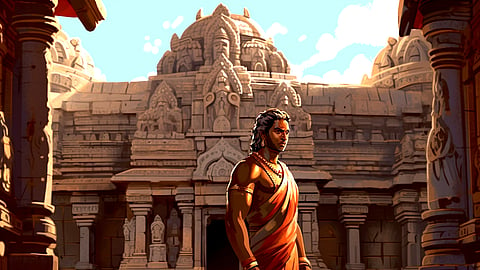- Commentary
- History Vignettes
- Notes on Culture
- Dispatches
- Podcasts
- Indian LanguagesIndian Languages
- Support

WHEN AENEAS GAZES at a mural depicting the battles of the Great Trojan War, his tongue involuntarily composes a heartfelt wail: “sunt lacrimae rerum et mentem mortalia tangunt!” — there are tears for things, and mortal things touch the mind! The mural has been found in the Carthaginian temple dedicated to Juno, the Goddess who is the protector and counsellor of the State. The battle scene is deeply personal to Aeneas: his beloved countrymen and his dear friends have become corpses painted on lifeless stone.
A kindred lament wells up within us when we read Hoysala history. Among all the great Hindu empires that flourished in the post-Gupta era, the Hoysala is marked by quite a unique eminence. Its three-century tenure was notable more for its cultural achievements than military exploits. No other Hindu empire before or after it had touched such exquisite perfection in sculptural art. In a way, the Hoysala Empire can be likened to a tragic hero in our national history. This owes mainly to two reasons. One, the grisly manner in which the Hoysala power was extinguished by serial Islamic invasions from Delhi. Two, the phenomenal rise of Vijayanagara, which eclipsed the Hoysala glory preceding it.
Happily for us, there is a wealth of historical information to accurately reconstruct the Hoysala era, and much good work has been done in this direction. There is literally a flood of literature related to Hoysala temples. It would be even better if a comprehensive work on the social life of that period was produced. Even the extant epigraphic evidence opens an enchanting and ennobling world from which we have much to learn.
THIS ESSAY SERIES NARRATES one such ennobling story from an inscription dated 1220 CE. The eponymous Hoysalesvara Temple in the Hoysala capital Halebidu (Dvarasamudra) is today a major “tourist attraction” both in Karnataka and India. It is common to see a sizeable population of western tourists admiring the magnificent temple, its arresting architecture and elegant sculptures. But what the average tourist and devotee alike misses is the treasure-trove of real-life stories that it contains. Our story is found engraved at the bottom of a pillar in the western enclosure of the temple complex.
First discovered in 1900-01, it narrates the extraordinary tale of Kuvara-Lakshma, a minister, general and close confidant of the Hoysala monarch, Vira Ballala II who ruled from 1173-1220. The grandson of the formidable Vishnuvardhana — the architect of Hoysala glory — Vira Ballala II surpassed his grandfather and transformed the Hoysala into a pan South-Indian Empire. In one imperial sweep, he battered the Devagiri Sevunas, clobbered the Southern Kalachuris, vanquished the Madurai Pandyas and decimated the Cholas of Thanjavur. All historians are unanimous in their verdict that he was the greatest Hoysala ruler. Kannada language and literature acquired a brilliant sheen under his patronage. His court poets included weighty names like Janna, Nemichandra and Rudrabhatta. The ornate temples of Kedareshwara (Halebidu), Amruteshwara (Amrutapura), Veeranarayana (Belavadi), and the twin ensembles Chennakeshava and Nageshvara (Mosale) were built during his regime. Vira Ballala II ascended the throne when he was just eighteen and departed the mortal world when he was just fifty-five, after building a vast empire. Today’s Hindu men aged fifty-five strut around in shopping malls and on beaches wearing ill-fitting Bermuda shorts like permanent adolescents.
Kuvara-Lakshma was the commander who stood rock-solid with his master till the very end — in war and peace. The aforementioned inscription, technically called the Garuda Pillar Inscription describes Kuvara-Lakshma in both laudatory and moving terms:
“Vira Ballala II’s minister was Kuvara-Lakshma. As if the (king’s) palace were his cradle, (the king’s) bounty, the oil for his mouth, his nurses were the members of the (king’s) female apartments—thus did king Ballala cherish Kuvara-Lakshma-dandadhisa (commander-in-chief). As a son Guru and deity alike was his ruler; both for this world and the next, no other god had Kuvara-Lakshma… Between servant and king there was no difference; the glory and marks of royalty were equal in both, and they both together protected the earth in great prosperity… Kuvara-Lakshma devoted his wealth and his life for the gifts and the victory of Vira-Ballala-Deva; and conquered the world for him as far as the southern ocean, bestowing unstinted charity on the learned and the scholars…” (Italics added)
Such deep attachment towards one’s Master and King was quite common in that era. But what distinguished Kuvara-Lakshma was the ultimate sacrifice that he performed in honour of Vira Ballala II.
That story will be narrated in the next episode.
To be continued
The Dharma Dispatch is now available on Telegram! For original and insightful narratives on Indian Culture and History, subscribe to us on Telegram.
